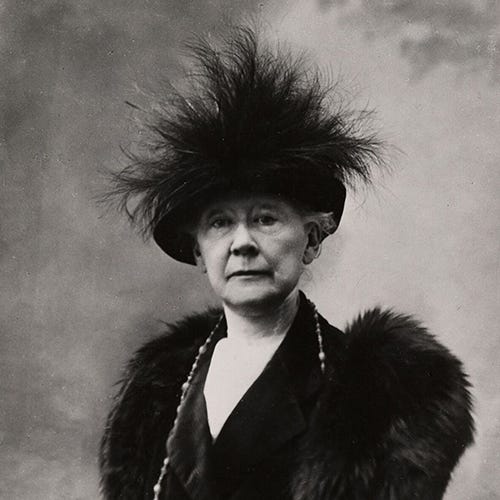Revealing Hidden Intimacy with Mary Cassatt
When we think of Impressionist painters, names like Claude Monet and Edgar Degas dominate the conversation. Female artists from this period are rarely mentioned, yet Mary Cassatt stands out not only for her gender but for her groundbreaking work.
An Artist Against All Odds
Mary Cassatt was born on May 22, 1844, to a wealthy family in Allegheny City, Pennsylvania, and grew up in an upper-middle-class environment. Her father was a stockbroker, and her mother came from a banking family.
While her father valued education for women, he didn’t see painting as a career for his daughter, expecting her to become a wife and mother.
But from an early age, Cassatt was determined to be an artist. At 15, she convinced her family to let her attend the Pennsylvania Academy of the Fine Arts, one of the few schools in America that allowed women to study painting.
However, the Academy was far from welcoming. Male instructors often dismissed female students, doubting their ability to produce “serious” art.
By the age of 22, frustrated by the limitations she faced in America, Cassatt made a bold decision to move to Paris. There, she spent hours at the Louvre, copying masterpieces and embarking on what would become a remarkable career.
Redefining Women's Roles in Art
Cassatt’s art didn’t follow the typical subjects of her time. While many of her contemporaries painted landscapes or grand historical scenes, she focused on the intimate world of women and children.
In a period when women were often portrayed as passive, decorative figures, Cassatt painted them as complex, thinking individuals.
“Women should be someone and not something.” - Mary Cassatt
Her work wasn’t sentimental or idealized. Instead, it captured candid, tender moments—mothers bathing their children, women quietly reading—revealing the emotional depth and complexity often overlooked in traditional art.
Defying Expectations
As an American woman in the male-dominated Parisian art world, Cassatt faced constant hurdles. She couldn’t attend the prestigious École des Beaux-Arts and was forced to find private tutors and continue her studies on her own.
Even when she began to gain recognition, she encountered resistance from critics who believed women weren’t suited for serious art.
In 1877, the Paris Salon rejected two of Cassatt's paintings. This rejection could have ended her career. Instead, it led to one of her biggest breakthroughs.
Breaking Boundaries with Degas
After her Salon rejection, Cassatt received an unexpected invitation from Edgar Degas that changed everything.
“The first sight of Degas' pictures was the turning point of my artistic life.” - Mary Cassatt
He admired her work and asked her to exhibit with the Impressionists. Cassatt jumped at the opportunity.
“There is someone who feels as I do.” - Edgar Degas
She became one of the few women and the only American to officially join the French Impressionists and exhibit alongside Monet, Renoir, and Degas. This opened new doors for her, and under their influence, she embraced bolder colors and innovative techniques.
Cassatt’s Masterpieces
Cassatt’s The Child’s Bath (1893) remains one of her most celebrated works. It captures the bond between mother and child from an intimate, overhead angle that draws viewers in and makes them a part of the moment.
Another significant piece, Little Girl in a Blue Armchair (1878), breaks away from the stiff, formal portraits of the time. The child’s relaxed posture, slouched in a chair, feels strikingly modern, emphasizing Cassatt’s talent for capturing natural, unguarded moments.
Cassatt was also deeply influenced by Japanese art, which led to her 1891 series of prints, including The Bath. These works, with their simplicity and two-dimensional forms, broke away from traditional Western artistic conventions.
A Champion for Women and Art
One of Cassatt’s most enduring legacies was her role in introducing Impressionism to America. She encouraged wealthy collectors like Louisine Elder and Harry Havemeyer to invest in Impressionist works that would later form the core of major museum collections, including the Metropolitan Museum of Art and the Museum of Modern Art in New York.
In 1893, Cassatt was commissioned to paint a mural for the Woman’s Building at the World’s Columbian Exposition in Chicago. Her piece, Modern Woman, was a bold celebration of women’s progress and achievements, highlighting the empowerment that was central to her work and life.
Beyond art, Cassatt was a fierce advocate for women’s suffrage and girls’ education. She used her influence to promote these causes, helping to give women the recognition they deserved in both art and society.
The Lasting Legacy of Mary Cassatt
Mary Cassatt died on June 14, 1926, at the age of 82, after years of failing health and near blindness. Her legacy endures not just through her art but through the path she paved for future generations of women artists.
“I am independent! I can live alone and I love to work.” - Mary Cassatt
Cassatt’s work gave dignity and importance to the domestic world, transforming it into something worth celebrating on canvas. She showed that women could succeed in a field not designed for them and became a symbol of what female artists could achieve.








What a beautifully written article on an extraordinary artist. I have always loved her art and admired her.
Excellent article about a significant artist! Thank you!